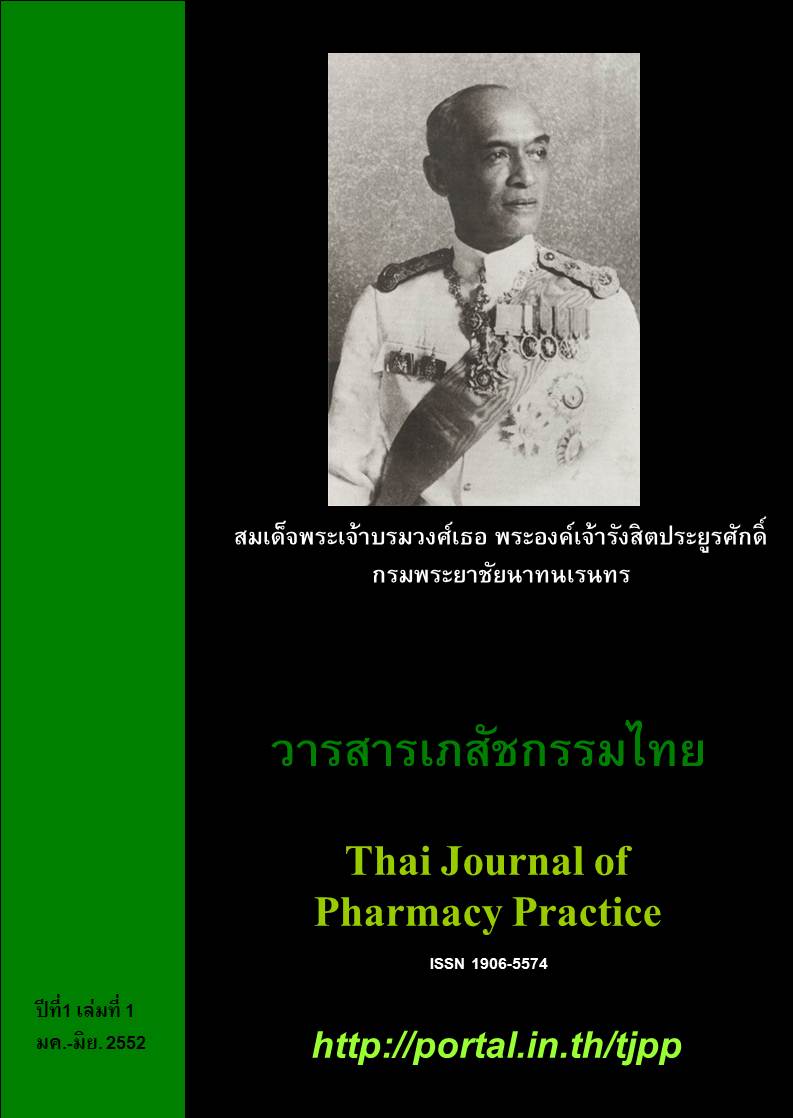The Relationship between Perceived Service Quality and Service Loyalty in Drug Stores, Bangkok
Main Article Content
Abstract
Objective: The aim of this study was to explore the relationship between perceived service quality (PSQ) and service loyalty (SL) in drugstores. Methods: Using a self-administered survey, data were obtained from a convenience sample of 408 customers from 12 drugstores randomly selected from the following six counties; Patumwan, Bangkapi, Prawet, Khlong Toei, Bang Khun Thian and Bangkok Noi. The questionnaires consisted of three parts: questions on demographic data, the SERVQUAL by Parazuraman et al. and the Behavioral Intentions Battery by Zeithaml et al. Results: The results showed the PSQ positively and significantly correlated with SL (r=0.719, p < .05). Results from stepwise multiple regression indicated three significant predictors of SL with r2=5.26: empathy (b=0.396; p<0.05); tangibles (b=0.207; p<0.05); responsiveness (b=0.190; p<0.05). Reliability and assurance did not appear to have a significant effect upon SL. Conclusion: The findings from this study can be useful for drugstore owners and professional organizations to improve pharmacy services, as well as maintain and build customer loyalty in the future.
Article Details
ผลการวิจัยและความคิดเห็นที่ปรากฏในบทความถือเป็นความคิดเห็นและอยู่ในความรับผิดชอบของผู้นิพนธ์ มิใช่ความเห็นหรือความรับผิดชอบของกองบรรณาธิการ หรือคณะเภสัชศาสตร์ มหาวิทยาลัยสงขลานครินทร์ ทั้งนี้ไม่รวมความผิดพลาดอันเกิดจากการพิมพ์ บทความที่ได้รับการเผยแพร่โดยวารสารเภสัชกรรมไทยถือเป็นสิทธิ์ของวารสารฯ
References
2. Rust RT, Zahorik AJ, Keiningham TL. Service marketing. New York: HarperCollins; 1996.
3. Dick AS, Basu K. Customer loyalty: toward an integrated conceptual framework. J Acad Mark Sci 1994;22:99-113.
4. กองควบคุมยา กระทรวงสาธารณสุข. สถิติใบอนุญาตประกอบธุรกิจเกี่ยวกับยาทั่วราชอาณาจักร ประจำปี 2539–2551 [ออนไลน์]. 2551 [สืบค้นวันที่ 10 มีนาคม 2552]. เข้าถึงได้จาก: HURL:http://wwwapp1H.fda. moph.go.th/drug/zone_search/sea001.asp
5. ลาวัณย์ บุนะจินดา. คุณภาพงานบริการเภสัชกรรมชุมชนในมุมมองของผู้รับบริการ และ เภสัชกร [วิทยานิพนธ์เภสัชศาสตรมหาบัณฑิต]. กรุงเทพฯ: จุฬาลงกรณ์มหาวิทยาลัย; 2547.
6. กัญจน์ญาดา นิลวาศ, นภาลัย นิรมิตกุศล, สุทัศวรรณ จิตรสุขสม. ความพึงพอใจของผู้รับบริการต่อบริการของร้านยาคุณภาพและร้านยาทั่วไป. วารสารวิชาการสาธารณสุข 2549;15:133-40.
7. Parazuraman A, Zeithaml VA, Berry LL. SERVQUAL: a multi scale for measuring customer perceptions of service quality. J Retailing 1988;64:12-40.
8. Kotler P. Marketing management. 11th ed. Upper Saddle River (NJ): Prentice Hall; 2003.
9. Zeithaml VA, Berry LL, Parasuraman A. The behavioral consequences of service quality. J Mark. 1996;60:31-46.
10. กองควบคุมยา กระทรวงสาธารณสุข. รายนามสถานที่ขายยาแผนปัจจุบัน กรุงเทพมหานคร [ออนไลน์]. 2551 [สืบค้นวันที่ 10 มีนาคม 2552]. เข้าถึงได้จาก: URL:http://wwwapp1.fda.moph.go.th/drug/zone_search/sea002.asp
11.พวงรัตน์ ทวีรัตน์. วิธีการวิจัยทางพฤติกรรมศาสตร์และสังคมศาสตร์. พิมพ์ครั้งที่ 8. กรุงเทพฯ: ศูนย์หนังสือจุฬาลงกรณ์มหาวิทยาลัย; 2543.
12. พนิตา นนทลีรักษ์, ศีลจิต อินทรพงษ์, ภิญญุภา เปลี่ยนบางช้าง. พฤติกรรมการเขียนฉลากยาของเภสัชกรชุมชนในเขตกรุงเทพมหานครและปริมณฑล. วารสารมหาวิทยาลัยนเรศวร 2548;14:27-34.
13. กานต์ วงศ์ศุภสวัสดิ์, ฐณัฏฐา กิตติโสภี, สามารถ เผ่า ภคะ. อิทธิพลจากรูปแบบคุณลักษณะของร้านยาต่อการกลับมาใช้บริการ: อิทธิพลของตัวแปรกำกับจากวัตถุประสงค์การซื้อ. วารสารเภสัชกรรมโรงพยาบาล 2551;18:10-26.
14. Baldinnger AL, Rubinson J. Brand loyalty: the link between attitude and behavior. J Advert Res 1996;36:22-34.

